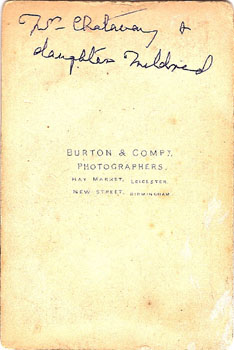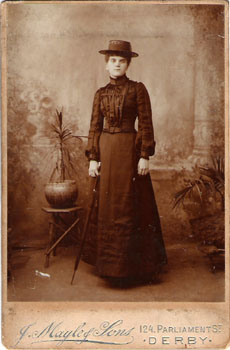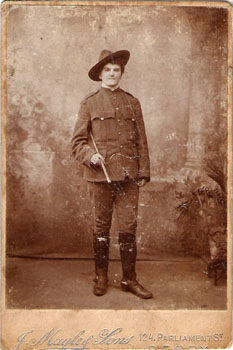This image of an early carte de visite by
John Burton & Compy. of Leicester and Birmingham was sent to me by James Morley, and was the subject of
some discussion on the
UK-Photographers Rootsweb Mailing List. I include it here, not only as a very early example of this well known photographer's work - see my
previous posting about this firm - but also because it shows the dangers in taking inscriptions on photographs at face value.


James originally posted this photo on the
WhatsThatPicture site. Reading the entries posted there and on the mailing list will tell the full story. It was originally thought that the young child apparently identified on the reverse of the mount as "Mildred" could have been the Mildred Chataway (born c. 1870), daughter of the Rector of Peckleton, Thomas E. Chataway, and his wife Catherine. However, several features of the photograph and mount suggest that it was taken perhaps a decade earlier than this interpretation would suggest:
- The full length seated pose is one which was commonly used in the 1850s, with daguerreotypes and ambrotypes, and 1860s, but the angled view - rather than direct frontal - is more characteristic, in my experierence, of the early 1860s. It is worth comparing it with this photo of a mother and child from London in Roger Vaughan's collection, dated 1862.
- Her hair completely covers her ears - another feature which points to the early 1860s. By the mid-1860s, ear lobes could often be seen, particular those of younger women, and they were fully exposed to the elements by the late 1860s. Also common in the early 1860s was the drawing back of the hair into a bun on the back of her head - almost, but perhaps not quite, a snood.
- The very wide sleeves and crinoline dress with velvety bands and very full skirts are characteristic of the early to mid 1860s, typified by the dress worn by the woman in another of Roger's photos, also from c. 1862. The wider sleeves tended to disappear by c.1864, exept on older women.
- The simple text with no adornment or logo on the reverse of the card mount points to a very early date. It was obviously produced after the opening of the branch studio in New Street, Birmingham (given by Sandy Barrie as 1861) and possibly before the Derby & Nottingham studios were opened in 1862 or 1863. Other early examples on my site are unfortunately not accurately dated, although estimates provided by David Simkin give c. 1861-1863. They all have more ornate logos than this one.
The rounded corners are unusual for the early 1860s, as is the shape of the carte de visite. The possibility has been considered that the rounding was produced by wear (in James Morley's words):
As for the rounded corners, I am in two minds. Some do look damaged, but top-left seems almost too perfect a curve. At the same time all four corners are very similar, whereas I would normally expect any damage to be uneven, particularly top-to-bottom.
The card mount measures 64 x 96 mm (photo 52.5 x 86 mm), which is somewhat shorter than the usual 64 x 104-106 mm for a carte de visite of that era. It is possible that it was an experimental format being trialled by Burton.
The "Burton & Compy." on the reverse may have some significance. It has been suggested that the firm started using the name "Burton & Sons" with some regularity from about 1864, and it seems likely that the "& Compy." suffix was used before John Burton's sons became formally recognised as part of the business. However, I don't have evidence for this. As Sandy has pointed out, production of new card mounts was erratic, particularly in the early days, and it is dangerous to interpret too much from the "& Compy."
Now that we have a date of c. 1860-1864 for the photograph, a further investigation can be made into the inscription. The 1871 Census indexed by
Ancestry only shows one Mildred Chat(t)away, aged 10 months, in Peckleton, Leicestershire. I used wildcards in the search parameters (Mild* and Chat*w*y) to cater for alternative spellings, but there is always potential for transcription errors, so other candidates can't be ruled out. However, the
FreeBMD index to birth, marriage and death records, which has
almost 100% coverage of the period in question, only shows one Mildred Chat(t)away born in England between 1850 and 1880:
- Births Sep Qtr 1870 :
Chataway Mildred Market Bosworth Regn Dist, Vol 7a Pg 61
This makes it very unlikely that the child in the photo is Mildred Chataway, and it the possibility needs to be considered that the inscription was made at a much later date, and in error. The 1871 Census entry for this family shows a number of other older daughters of Rev. Thomas and his wife Catherine:
1871 Census: The Vicarage, Peckleton LEI Ref. RG10/3240/7/7-8/40:
Thomas E. CHATTAWAY / Head / M / M / 44 / Rector of Peckleton / WAR Birmingham
Catherine S. CHATTAWAY / Wife / M / F / 37 / - / WOR Redditch
Katherine A. CHATTAWAY / Dau / - / F / 13 / Scholar / NTH Ecton
Agnes G. CHATTAWAY / Dau / - / F / 7 / Scholar / NTH Ecton
Margaret A. CHATTAWAY / Dau / - / F / 6 / - / LEI Peckleton
Christiana M. CHATTAWAY / Dau / - / F / 4 / - / LEI Peckleton
Ella B. CHATTAWAY / Dau / - / F / 3 / - / LEI Peckleton
Mildred CHATTAWAY / Dau / - / F / 10m / - / LEI Peckleton
Catherine CHATTAWAY / Mother / Wid / F / 81 / Annuitant / WAR Coventry
Jessie M. GORHAM / Board / U / F / 23 / Governess / KNT Tunbridge
Cecile C.V. KERR / Board / U / F / 14 / Scholar / Gibraltar
Mary BARWELL / Serv / U / F / 33 / Cook Domestic / LEI Carlton
Lucy LUCAS / Serv / U / F / 28 / Nurse Domestic / NTH Church Stone?
Hannah JACQUES / Serv / U / F / 21 / Housemaid Domestic / STS Walsall
Emma BENT / Serv / U / F / 20 / Housemaid Domestic / LEI Peckleton
Martha AMOS / Serv / U / F / 14 / Under Nurse / NTH Badby
FreeBMD demonstrates that the birth of the oldest daughter, Katherine Ada Chataway, was registered in early 1858 in the Wellingborough Registration District, which includes the village of Ecton. I estimate an age of between two and three years for the girl, so Katherine might be a potential candidate if the photograph was taken, as suggested between 1860 and 1864. Birth locations of the children shown in the above census extract indicate that the family moved from Ecton (Northamptonshire) to Peckleton (Leicestershire) some time between the births of Agnes Georgina, in late 1863, and Margaret Anne, in early 1865. If indeed this picture is of members of the Chataway family, and that is by no means certain, then it is unlikely to have been taken prior to late 1863, by which time Katherine would have been almost six years old. In that case, it is more likely to have been a different daughter, perhaps Fanny Mabel, who was born at Ecton in early 1861 and died at Peckleton, aged 5, in the first half of 1866.
Many thanks to James Morley for permission to use the images of this photograph, to James, Sandy Barrie and Marcel Safier for their interesting and informative contributions to the discussion, and to Roger Vaughan and David Simkin for examples used.


























































